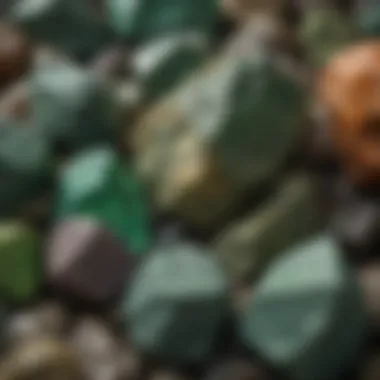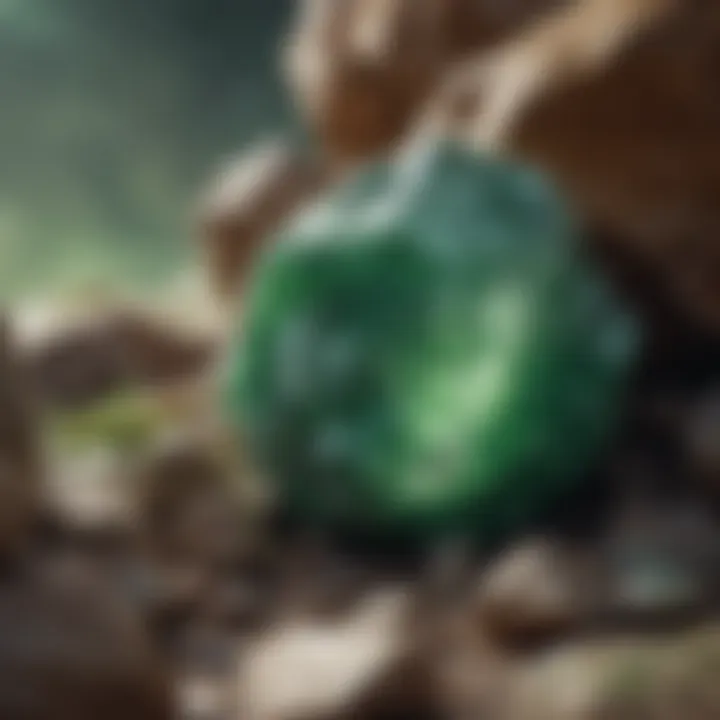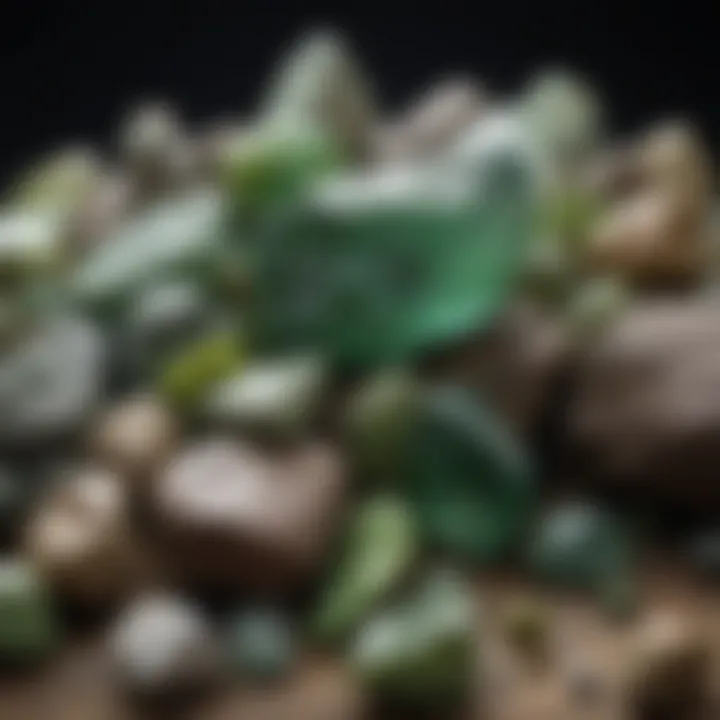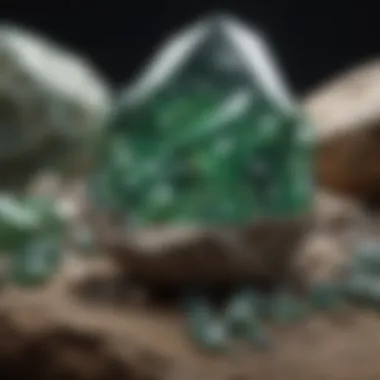An In-Depth Exploration of Green Rock Minerals


Intro
Green rock minerals are a captivating subject within the realm of geology and mineral collections. Known for their distinct hues and unique properties, these minerals can often tell us a lot about geological processes. This article will delve into various facets of green rock minerals, focusing on their formations, classifications, and their relevance to collectors and the environment.
This exploration not only serves as an informative guide for enthusiasts but also highlights the importance of these minerals within ecosystems. By examining specific examples, readers can grasp the broader significance of green rock minerals in both natural settings and human-based collections.
Understanding Green Rock Minerals
The study of green rock minerals is fundamental in geology and mineralogy. These minerals not only contribute to the aesthetic value of collections but also provide insights into geological processes and environments. Understanding green rock minerals means comprehending how they form and their implications in various systems.
For collectors and enthusiasts, knowledge in this area means a richer experience when identifying and categorizing specimens. It enhances appreciation of their uniqueness, which arises from their colors, compositions, and the conditions under which they formed. It’s not just about collecting rocks; it's about understanding their stories.
Additionally, the ecological roles that green minerals play contribute further depth to their importance. From influencing soil composition to supporting plant growth, the functionalities of these minerals extend beyond mere visual appeal.
In this section, we delve into essential components such as definitions, classifications, and geological significance of green rock minerals.
Definition and Classification
Green rock minerals can be defined as minerals that exhibit a green hue, which results from various chemical compositions, including iron, chromium, and manganese, among others. Classification of these minerals often depends upon their crystal structure, chemical properties, and the geological setting in which they occur.
Some commonly acknowledged classifications include:
- Silicates: Such as olivine and serpentinite, rich in silicon and oxygen.
- Carbonates: Like chrysoprase, which contains a significant amount of copper.
- Borosilicates: Such as green tourmaline, featuring mixed elements.
Each group presents a different perspective on their roles and significance in nature and human utilization. A precise classification helps in both educational contexts as well as practical identification during fieldwork.
Geological Significance
The geological significance of green rock minerals lies in their ability to reflect the conditions of formation and the environments where they are found. These minerals often indicate specific geological processes, such as volcanic activity or metamorphism.
For instance, olivine is typically found in mafic igneous rocks and can point towards formation environments characterized by high temperatures. Conversely, minerals like serpentine can arise from the alteration of ultramafic rocks under conditions of low temperature and pressure, reflecting significant metabolic processes.
Understanding these minerals can reveal historical context about Earth’s dynamic nature. Furthermore, their distribution often aligns with valuable geological resources, guiding exploration and extraction efforts.
"The study of green rock minerals offers a window into the Earth's history and the processes that have shaped its surface, providing invaluable insights for both scientists and collectors."
By engaging with green rock minerals, enthusiasts and scholars unlock a greater understanding of not only the minerals themselves but of the Earth's geological narrative.
Formation Processes of Green Minerals
Understanding the formation processes of green minerals is central to comprehending their distinct characteristics and relevance. The processes dictate the mineral's structure, composition, and ultimately its usability in various applications. By studying these formation methods, one can appreciate how these minerals evolve over time, influenced by the geological environment around them. Such knowledge is beneficial not just for collectors, but also for geologists and researchers interested in the properties and potential uses of these minerals.
Igneous Processes
Igneous processes are crucial to the formation of many green minerals. These processes occur when molten rock, known as magma, cools and solidifies. During this cooling, various minerals crystallize from the magma at different temperatures. Green minerals like olivine are formed through this process.
Olivine is often found in mafic and ultramafic igneous rocks, which are rich in magnesium and iron. The composition of these minerals is influenced by the specific conditions under which the magma cools, as well as its chemical composition.
Key aspects of igneous processes include:
- Temperature and Pressure: Higher temperatures and pressures can lead to the formation of specific green minerals.
- Magma Composition: Variations in the chemical makeup of magma affect the types of minerals that crystallize, influencing the final mineral assemblage.
- Cooling Rate: Slow cooling allows for larger crystal growth, while rapid cooling creates smaller crystals.
The significance of igneous processes lies in their ability to reveal information about the Earth’s interior and the conditions that existed during mineral formation.
Metamorphic Changes


Metamorphic changes account for another significant route to the formation of green minerals. This process involves the alteration of existing rocks under extreme heat and pressure. Original rock types, including igneous, sedimentary, or even other metamorphic rocks, can undergo transformation into new mineralogical compositions. Green minerals like serpentine can form during the metamorphism of ultramafic rocks rich in olivine and pyroxene.
The fundamental factors in metamorphic processes include:
- Temperature: High temperatures induce the stability of new minerals, often resulting in a green coloration due to the presence of specific elements.
- Pressure: Increased pressure changes the crystalline structure of minerals, affecting their final appearance and properties.
- Chemical Environment: Fluids can play a key role in the metamorphic process, as they can facilitate the movement of ions necessary for new mineral formation.
These metamorphic changes lead not only to the emergence of new green minerals but also enrich our understanding of geological history and tectonic processes.
Sedimentary Origins
Sedimentary origins provide yet another dimension to the formation processes of green minerals. These minerals can arise from the weathering and subsequent deposition of existing rocks. Through a process of erosion, fragments of green minerals can accumulate in sedimentary basins. Minerals such as chrysoprase, which is a form of chalcedony, form specifically from the diagenesis of silica-rich materials often enriched in nickel.
Key factors influencing the sedimentary formation process include:
- Weathering: Physical and chemical breakdown of pre-existing minerals leads to the release of materials that can form secondary minerals.
- Transport: Water, wind, or ice can carry these fragments to different locations, where they can accumulate and undergo further alteration.
- Deposition: The settling of sediments in a stable environment allows for the formation of layered deposits, sometimes resulting in the enrichment of certain green minerals.
Through sedimentary processes, collectors can find gems and other valuable green minerals, showcasing nature’s ability to create beauty in diverse environments.
The formation of green minerals is a complex interplay of geological processes that not only defines their physical properties but also offers insight into Earth's dynamic systems.
Types of Green Rock Minerals
The categorization of green rock minerals is crucial in understanding both their geological origins and their practical applications. Green minerals are not merely aesthetically distinct; they also indicate specific environmental conditions during their formation. Recognizing different types is beneficial for various reasons. It allows enthusiasts and collectors to identify key characteristics and offers insights into mining, gardening, and ecoengineering. Each mineral has unique properties, including hardness, opacity, and chemical composition, which can influence their use in different industries. This knowledge aids both collectors in their pursuits and scientists in their research endeavors.
Olivine
Olivine is a common and significant mineral occurring in a range of geological settings. Visually, it is often found in yellowish-green to olive-green shades, making it distinct among green minerals. This mineral is primarily composed of magnesium and iron silicate. A notable feature of olivine is its presence in ultramafic rocks like peridotite and basalt.
From a geological perspective, olivine serves as a critical indicator of mantle processes and contributes to understanding the earth's interior structure. Collectors appreciate olivine for its crystal formations and vibrant color. Additionally, olivine is sometimes used in industry as a refractory material due to its high melting point. The appreciation for olivine extends beyond geology; it's also used in jewelry, especially in the form of peridot gemstones.
Serpentine
Serpentine represents a group of minerals that primarily consist of magnesium silicate. Often referred to for their snake-like appearance, these minerals range in color from deep green to light green. They form through the alteration of olivine and pyroxene under conditions of low temperature and pressure.
The ecological importance of serpentine cannot be overstated. Serpentine soils, known for their high magnesium and low nutrients, support unique plant communities capable of thriving in these harsh conditions. This has implications for biodiversity and conservation. Collectors often prize serpentine for its aesthetic value, as it can display a beautiful range of colors and intricate patterns. Moreover, serpentine is sometimes utilized in sculpture and decorative arts.
Chrysoprase
Chrysoprase is a variety of chalcedony that exhibits a rich, apple-green hue, which is attributed to the presence of nickel. This mineral is particularly valued in jewelry-making for its vibrant color and translucence. Its brightness and clarity make it a sought-after gemstone, and it has been utilized throughout history in various cultures for both ornamental and practical purposes.
Geologically, chrysoprase often forms in secondary deposits where silica-rich solutions infiltrate and crystallize in cavities. It is important in understanding late-stage hydrothermal processes. For collectors, the provenance of chrysoprase can greatly influence its value, with specimens from specific localities being more sought after. This gemstone also holds significance in alternative medicine, where it is thought to have calming properties.
Green Tourmaline
Green tourmaline, a member of the complex tourmaline group, is known for its diverse color range, often including deep forest green to bright lime hues. It is composed of boron silicate and can be found in granite pegmatites. One unique aspect of green tourmaline is its pyroelectric properties, meaning it can generate an electric charge when heated or subjected to pressure.
This mineral is especially remarkable for its abundance in a variety of geological settings, making it a staple among collectors. Green tourmaline is often used in jewelry for its attractive appearance, but it also plays a role in electronics and energy storage due to its unique electrical properties. For mineral enthusiasts, understanding the crystal structure and formation of green tourmaline enhances the appreciation for its place in both geology and valuable sectors.
Identification Techniques
Identification techniques for green rock minerals are crucial for collectors, geologists, and enthusiasts alike. They assist in accurately determining the mineral type, assessing its quality, and understanding its geographical origin. Proper identification enables collectors to gain insight into the mineral's properties, potential uses, and ecological significance.
Visual Characteristics
Visual inspection often provides the first indication of a mineral's identity. Green rock minerals exhibit distinct colors, patterns, and textures that can help in their identification. For instance, olivine is generally olive-green and glassy, while serpentine showcases a more fibrous structure, often with a mottled appearance. Key visual features to observe include:


- Color: The hue can vary significantly, from deep emerald greens in chrysoprase to lighter greens in some varieties of serpentine.
- Luster: How the mineral reflects light can indicate its composition. For example, a glassy luster typically indicates a higher silica content.
- Transparency: Many green rock minerals are not transparent, but variations exist that can help distinguish one from another.
- Habit: The physical form of the mineral, such as whether it is granular or fibrous, contributes to identifying it.
Collectively, these visual characteristics are foundational for initial mineral identification, providing a tangible basis for further testing.
Spectroscopic Methods
Spectroscopic techniques are valuable for precise identification of minerals, especially when visual characteristics are not definitive. Instruments like handheld X-ray fluorescence (XRF) analyzers and Raman spectrometers facilitate this process. These methods interact with the mineral's atomic structure and can pinpoint chemical composition. Key aspects of spectroscopic methods include:
- Elemental Analysis: XRF can detect elements with high accuracy, helping identify specific metal ions present in the mineral.
- Vibrational Modes: Raman spectroscopy explores molecular vibrations, giving insight into the mineral's crystal structure and composition.
- Non-Destructive Testing: Unlike some other methods, these techniques do not alter the mineral, preserving its integrity for display purposes.
Utilizing spectroscopic methods can significantly enhance accuracy in identifying green rock minerals, especially for complex specimens that may appear similar.
Field Tests
Field testing techniques are practical approaches used by collectors and geologists to ascertain mineral identities in situ. These tests complement visual inspections and spectroscopic methods, providing immediate, on-the-spot results. Some common field tests for green rock minerals include:
- Hardness Test: By using the Mohs scale of hardness, collectors can scratch the mineral against known materials to gauge its hardness level.
- Streak Test: Rubbing the mineral on an unglazed porcelain plate reveals the powder color, which can be a more consistent identifying feature than the surface color.
- Acid Test: A weak acid can be applied to some minerals to observe effervescence, indicating the presence of carbonates.
Field tests, while simple, provide accessible tools for those engaging with green rock minerals outside of lab environments. They encourage a direct interaction with the material and contribute to an enhanced understanding of geological varieties.
Proper identification techniques are essential for not only understanding green rock minerals but also for advancing the knowledge in geology and mineralogy.
Ecological Roles of Green Minerals
Green minerals are not just visually striking; they also play essential roles in ecological systems. Their presence can significantly alter and enhance local environments, supporting various biological processes. This section explicates the crucial functions of green minerals in ecosystems, particularly in soil formation and their influence on plant growth.
Soil Formation
The process of soil formation is deeply intertwined with the presence of minerals, including green ones. Green minerals, such as olivine and serpentine, weather over time to contribute essential nutrients to the soil. Through weathering, these minerals release elements like magnesium and iron, which are vital for various biochemical reactions.
- Nutrient Release: The gradual breakdown of green minerals provides macro and micronutrients crucial for soil health.
- Soil Structure: Green minerals can contribute to the aggregation of soil particles, improving soil structure and porosity. This structure helps retain moisture and enhances drainage.
- pH Regulation: Some green minerals can influence the pH levels in the soil. For instance, serpentine tends to produce alkaline soils enhancing certain plant communities while limiting others.
"The presence of green minerals plays a pivotal role in maintaining the health and fertility of soil ecosystems."
The contribution of green minerals in these processes illustrates their foundational role in nurturing ecosystems. It's crucial to recognize that degradation of areas rich in these minerals can lead to soil erosion and loss of biodiversity.
Plant Growth Influence
Green minerals also have a profound impact on plant growth and health. The composition of soil enriched with green minerals can significantly affect plant development.
- Nutrient Availability: Plants absorb nutrients released from green minerals, which directly supports growth.
- Plant Specificity: Certain plants thrive in soils rich in specific green minerals. For example, plants adapted to serpentine soils often exhibit features that allow them to deal with unique soil chemistry.
- Microbial Activity: The minerals foster an environment conducive to microbial life, which aids in nutrient cycling. This symbiotic relationship between minerals, microbes, and plants enhances soil fertility and sustainability.
The interplay between green minerals and plant life underscores their ecological significance. Protecting these minerals contributes to the health of ecosystems and reinforces the importance of sustainable practices in relevant industries.
Cultural and Economic Importance
Green rock minerals hold significant value in various cultural and economic contexts. They are not only appreciated for their aesthetic qualities but also recognized for their utility in different industries. Understanding this importance can provide collectors with deeper insights into their collections as well as their historical and contemporary significance.
Historical Uses
Historically, green minerals were used in several cultures for both practical and decorative purposes. For instance, olivine has been noted in ancient artifacts, particularly in jewelry, due to its vibrant green hue. Similarly, serpentine was commonly used in carving and sculpture by ancient civilizations, showcasing its appeal as a decorative stone. Some cultures believed that these minerals had protective properties or promoted healing, leading to their incorporation into rituals and spiritual practices.
"Throughout history, green minerals have been symbols of vitality and renewal in many cultures."
The utility of these minerals extended beyond mere decoration. Green minerals like jade, favored in many Asian cultures, were believed to bring good fortune and were often used in amulets. Their historical role highlights how different societies have valued these geological treasures for their physical and metaphysical properties.


Modern Applications
In contemporary times, the applications of green minerals have broadened significantly. They play a vital role in various industries. For example, olivine is being explored for its potential in environmental applications, like carbon capture. This process involves using olivine to absorb CO2, thereby contributing to efforts in climate change mitigation.
Moreover, the aesthetic qualities of green minerals continue to thrive in modern jewelry and art. Designers increasingly seek out unique, ethically sourced green stones for their creations. This trend is not limited to jewelry; it also spans home decor, where materials like green marble and jade are sought after for their striking appearances.
Additionally, the rise of the wellness industry has sparked an interest in the metaphysical properties attributed to various green rocks. Many consumers are drawn to them for their purported healing capabilities, which enhances their market demand.
In summary, the cultural and economic importance of green rock minerals transcends time. Their historical relevance and modern applications illustrate their enduring appeal as both collectibles and resources for various industries.
Collecting Green Rock Minerals
Collecting green rock minerals can be both an engaging hobby and a serious pursuit for many enthusiasts. These minerals, which vary widely in type and origin, offer not just aesthetic appeal but also insights into geological processes and Earth's history. For collectors, understanding the distinct features of different green minerals can lead to more informed choices about what to seek and add to their collections.
When starting in this field, collectors should consider a few key elements. Knowledge of locations where green minerals are found is essential. Often, these locations have historical significance or unique geological features that can enhance the value of collected specimens. A collector’s mindset should include respect for local regulations and environments. Extracting minerals should never disturb ecosystems or violate land use laws. By adhering to responsible gathering practices, collectors can enjoy their hobby sustainably.
"The joy of collection lies not only in acquiring but in understanding."
Additionally, the benefits of collecting green rock minerals extend beyond individual satisfaction. Educating oneself on the types, compositions, and backgrounds of these minerals fosters a deeper appreciation for their role within both natural sciences and cultural contexts. This knowledge can also position collectors within larger communities which share similar interests, opening doors to discussions, showcases, and even opportunities for trade.
Best Practices for Collectors
In the realm of collecting, certain best practices are advisable to ensure a rewarding experience. Here are some crucial tips:
- Do Research: Before heading out to collect, research the types of green minerals you might find in specific regions. Understanding geological formations can guide your search effectively.
- Use Proper Tools: Carry essential tools such as a rock hammer, safety goggles, and a field notebook to document your findings. A good collection bag can protect your specimens during transport.
- Observe Legal Guidelines: Always check if collecting is allowed in your chosen area. National parks, reserves, and some private lands have strict regulations regarding mineral collection.
- Be Mindful of Safety: Collecting can involve tricky terrains. Wear appropriate footwear and consider potential hazards when exploring new places.
- Collaborate: Engage with local rock clubs or online communities. Sharing knowledge and experiences can enhance your collection journey.
Display and Preservation Techniques
Once collected, the next vital step is how to display and preserve these green rock minerals. Proper display not only showcases your collection but also protects it from damage. Key techniques include:
- Use of Display Cases: Invest in UV-filtering display cases to protect minerals from sunlight. Avoid direct exposure to reduce fading and alteration of colors.
- Cleaning and Care: Clean minerals gently with a soft brush or cloth. Avoid harsh chemicals that could damage the surface. Some minerals may require specific care, so research individual specimens.
- Labeling: Clearly label each specimen with its name, location of collection, and any relevant details. This provides context and enhances the educational value of the display.
- Temperature and Humidity Control: Store collected minerals in controlled environments, away from extreme temperatures and humidity, to prevent deterioration.
By employing these practices, collectors can take steps to ensure their collections remain resplendent and informative over time.
Resources for Enthusiasts
Resources for enthusiasts provide critical foundations for those interested in green rock minerals. They serve as gateways to deeper understanding, better practices in collecting, and enhanced appreciation of these geological wonders. Having access to accurate and reliable information empowers collectors to identify, source, and care for their specimens more effectively.
Field Guide Recommendations
Field guides are essential for any serious collector of green rock minerals. These books offer detailed descriptions, photographs, and classification keys that simplify the identification process. Among the most recommended guides are:
- Minerals of the World by Claude Dufour: This guide presents comprehensive information on mineralogy, including green minerals.
- The Rock Collector's Handbook by Jean P. Eggen: It includes techniques for collecting and identifying various rock types, featuring a section on green minerals.
- The Field Guide to Minerals by John R. Wilson: This guide focuses on field identification and locality information, essential for field trips.
Investing in these resources will not only enrich a collector's knowledge but also enhance their experience when exploring new sites or attending mineral shows.
Online Communities and Forums
Online platforms have become indispensable for enthusiasts engaged in the study and collection of green rock minerals. Forums and community sites like Reddit or dedicated Facebook groups facilitate information exchange, allowing collectors to share experiences, seek advice, and showcase their finds.
Key advantages of participating in online communities include:
- Networking Opportunities: Engaging with others allows collectors to connect with more experienced individuals, which can lead to potential mentorship or collaborations.
- Knowledge Sharing: Enthusiasts can ask questions about specific minerals or seek recommendations for tools and techniques.
- Event Updates: Many community members share announcements about mineral shows, club meetings, or field trips, helping enthusiasts stay informed.
Here are a few recommended online communities:
- Reddit's r/rocks and r/mineralogy: These subreddits are treasure troves of information shared by both hobbyists and professionals.
- Facebook Groups: Many local and global groups exist for mineral collectors. They often share tips and insights about collecting and preserving specimens.
Participating in these communities fosters a sense of belonging and encourages ongoing learning, vital in a field that constantly evolves.
By making use of recommended field guides and engaging in online communities, rock and fossil collectors can significantly enhance their knowledge and skills regarding green rock minerals.



